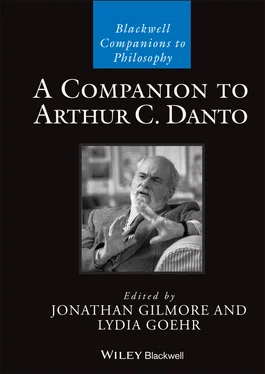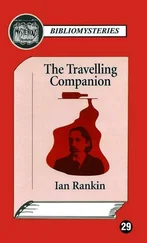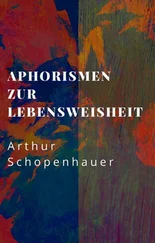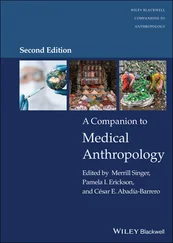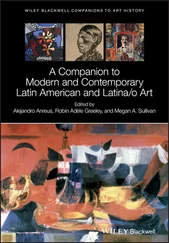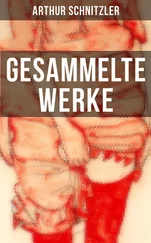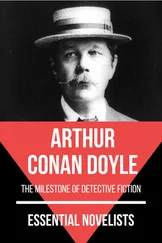A Companion to Arthur C. Danto
Здесь есть возможность читать онлайн «A Companion to Arthur C. Danto» — ознакомительный отрывок электронной книги совершенно бесплатно, а после прочтения отрывка купить полную версию. В некоторых случаях можно слушать аудио, скачать через торрент в формате fb2 и присутствует краткое содержание. Жанр: unrecognised, на английском языке. Описание произведения, (предисловие) а так же отзывы посетителей доступны на портале библиотеки ЛибКат.
- Название:A Companion to Arthur C. Danto
- Автор:
- Жанр:
- Год:неизвестен
- ISBN:нет данных
- Рейтинг книги:5 / 5. Голосов: 1
-
Избранное:Добавить в избранное
- Отзывы:
-
Ваша оценка:
- 100
- 1
- 2
- 3
- 4
- 5
A Companion to Arthur C. Danto: краткое содержание, описание и аннотация
Предлагаем к чтению аннотацию, описание, краткое содержание или предисловие (зависит от того, что написал сам автор книги «A Companion to Arthur C. Danto»). Если вы не нашли необходимую информацию о книге — напишите в комментариях, мы постараемся отыскать её.
Companion
A Companion to Arthur C. Danto
A Companion to Arthur C. Danto — читать онлайн ознакомительный отрывок
Ниже представлен текст книги, разбитый по страницам. Система сохранения места последней прочитанной страницы, позволяет с удобством читать онлайн бесплатно книгу «A Companion to Arthur C. Danto», без необходимости каждый раз заново искать на чём Вы остановились. Поставьте закладку, и сможете в любой момент перейти на страницу, на которой закончили чтение.
Интервал:
Закладка:
Perception itself already has expressive significance, for the body itself brings a style of comportment to its apprehension of what it perceives: “if expression recreates and transforms, the same was already true … of our perception of the world before painting, since that perception already marked things with the trace of human elaboration” (1993 [1945, 1952], 96). We find ourselves with unique and individually recognizable ways of walking and talking, and artistic expression is a further deliberate refinement of those spontaneous dispositions: “For each painter, style is the system of equivalences that he sets up for himself” (1993 [1945, 1952], 91). The cultivated body schema of the artist is a kind of second nature, a set of acquired yet spontaneous skills, which come to feel natural though they are products of years of effort and practice. Carving out a unique artistic style, over and beyond one’s everyday personal way of moving and speaking, is like learning a second language. Merleau-Ponty therefore refers to “the painter’s labor and study, that effort that is so like an effort of thought and that allows us to speak of a language of painting” (1993 [1945, 1952], 92). If painting is a language, it is a language learned with reference to the more primitive means of expression inherent in ordinary perceptual behavior.
By recognizing artistic expression as an extension and refinement of the already inherently stylized nature of ordinary perception and speech, Merleau-Ponty reminds us that human experience and understanding do not have the rigidly dualistic character that Sartre describes in his distinctions between pour-soi and en-soi , transcendence and facticity, prose and poetry. Danto, I believe, found Sartre’s conceptual apparatus useful, but only up to a point. By drawing attention to the extremes of subjective and objective, transparency and opacity, spontaneity and character, Sartre cast indirect light on what falls between those extremes, namely, the manifest style of expressive works that transfigure what they disclose by, in Danto’s words, “externalizing a way of viewing the world” (1981, 208). But how is such a thing possible? Crucial to Danto’s formula is precisely that the (so-called) “externalization” accomplished in works of art cannot just be the reification and alienation of a (so-called) “internal” point of view, but must manifest or disclose a “way of viewing the world” in its – always already – outward, worldly aspect. World is not outside, perspective is not inside. In describing art as imbued with meaning – as rhetorically inflected, metaphorically rich, transfigurative – Danto recognized the worldly context of significance that Sartre’s categories indicate only negatively, and so threaten to render unrecognizable.
References
1 Danto, Arthur C. 1964. “The Artworld.” The Journal of Philosophy 61(9): 571–584.
2 ———. 1975. Jean-Paul Sartre. New York: Viking.
3 ———. 1981. The Transfiguration of the Commonplace: A Philosophy of Art. Cambridge, MA: Harvard University Press.
4 Evans, Gareth. 1982. Varieties of Reference. Edited by John McDowell. Oxford: Oxford University Press.
5 Kierkegaard, Søren. 2001 [1846]. A Literary Review. Translated by Alastair Hannay. New York: Penguin.
6 Merleau-Ponty, Maurice. 1993 [1945, 1952]. The Merleau-Ponty Aesthetics Reader. Edited and Translated by Michael B. Smith. Evanston: Northwestern University Press.
7 Moore, George Edward. 1993 [1903]. “The Refutation of Idealism.” In Selected Writings, edited by T. Baldwin. London: Routledge, pp. 23–44.
8 Sartre, Jean-Paul. 1964 [1938]. Nausea. Translated by Lloyd Alexander. New York: New Directions.
9 ———. 1988 [1948]. “What Is Literature?” and Other Essays. Translated by Bernard Frechtman. Cambridge, MA: Harvard University Press.
10 ———. 2018 [1943]. Being and Nothingness: An Essay in Phenomenological Ontology. Translated by Sarah Richmond. London: Routledge.
11 Wittgenstein, Ludwig. 1958. The Blue and Brown Books. New York: Harper & Row, 2nd edn., 1960.
5 Nietzsche and Historical Understanding 1
ROBERT GOODING-WILLIAMS
In the “Acknowledgements” to Nietzsche as Philosopher: Expanded Edition (2005), Arthur Danto explains that the book’s first edition grew out of an essay he wrote at the invitation of Paul Edwards to contribute an article on Nietzsche to A Critical History of Western Philosophy (1964), edited by D.J. O’Connor. 2Danto penned the essay in Rome where, having just moved there from the south of France, he had completed a draft of his first major book, Analytical Philosophy of History (1965). 3In exchange for shortening his contribution to O’Connor’s volume, Edwards offered Danto a contract to write a monograph on Nietzsche. Danto finished the manuscript in the summer of 1964, and both Nietzsche as Philosopher and Analytical Philosophy of History were published the following year.
Lydia Goehr has remarked that “Nietzsche hardly makes an appearance” in Analytical Philosophy of History (Goehr 2007, xxxviii). It is true, however, that Danto’s philosophy of history “makes an appearance” in the initial edition of his Nietzsche book and in a series of essays on Nietzsche that he wrote between 1965 and 2005 – essays subsequently appended to the book’s “Expanded Edition.” Danto invokes his philosophy of history to authorize a reading of Nietzsche that, I shall argue, his philosophy of history nevertheless undermines.
In Danto’s view, Nietzsche’s books, no less than his thoughts and doctrines, have a disjointed, even disparate appearance that Danto attributes to Nietzsche’s aphoristic and essayistic literary style, as well as to an abrupt and impromptu method of composition that knew nothing of the “architectonic feeling for structure” evident, say, in Kant’s writings (Danto 2005, 1–4). This appearance notwithstanding, Danto purports to find in Nietzsche’s writing a coherent, systematic structure pivoting around the idea of philosophical nihilism – the thesis that there is in the world “neither order nor purpose, things nor facts, nothing there whatever to which our beliefs can correspond” (Danto 2005, 12, 15). The point of Nietzsche as Philosopher , he tells us, is to reconstruct that structure: to show how Nietzsche’s philosophical nihilism is linked to his other principal ideas, including his perspectivism, which holds that there are no facts, only interpretations; his religious psychology, which explains the origins of our now conventional morality; and his affirmations of life, which express his ideas about the Übermensch, the eternal recurrence, and amor fati . Danto imputes the structural coherence of Nietzsche’s thought to two factors.
One factor is the systematic, architectonic nature of philosophy as such, “which imposes an external regimen upon its least systematic practitioners … philosophers are systematic through the nature of their enterprise.” Danto’s point is not that Nietzsche “ intended his work” to exhibit structural coherence – indeed, Danto claims that he could not have intended this, for “by his own admission” he was unaware of the system that his writings embodied. Rather Nietzsche’s writings exhibit a coherent structure because Nietzsche concerned himself with philosophical problems, and because “the problems of philosophy are so interconnected that the philosopher cannot solve, or start to solve, one of them without implicitly committing himself to solutions for all the rest.” Danto’s Nietzsche was a system builder, for, “if only tacitly,” he submitted his thinking to the demands of the philosophical “discipline,” “where there is no such thing as an isolated solution to an isolated problem” (Danto 2005, 6–7).
Читать дальшеИнтервал:
Закладка:
Похожие книги на «A Companion to Arthur C. Danto»
Представляем Вашему вниманию похожие книги на «A Companion to Arthur C. Danto» списком для выбора. Мы отобрали схожую по названию и смыслу литературу в надежде предоставить читателям больше вариантов отыскать новые, интересные, ещё непрочитанные произведения.
Обсуждение, отзывы о книге «A Companion to Arthur C. Danto» и просто собственные мнения читателей. Оставьте ваши комментарии, напишите, что Вы думаете о произведении, его смысле или главных героях. Укажите что конкретно понравилось, а что нет, и почему Вы так считаете.
